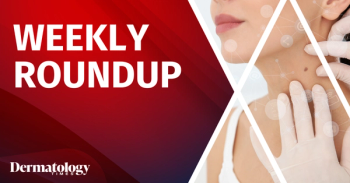
Journal Digest: May 28
Key Takeaways
- A study found 14.3% of psoriasis patients had arthritis before skin lesions, challenging traditional beliefs about psoriatic arthritis onset.
- Adipose mesenchymal stem cell-derived exosomes and platelet-rich plasma showed comparable efficacy in improving photoaged facial skin.
This review of the latest dermatologic studies includes insights into psoriatic lesions and PsA, adipose mesenchymal stem cell-derived exosomes versus platelet-rich plasma, and more.
International Journal of Dermatology: Challenging the Dogma That Psoriasis Skin Lesions Occur Before Arthritis
A study investigated the timing of psoriatic arthritis (PsA) onset relative to psoriasis diagnosis, challenging the common belief that skin lesions precede joint symptoms. Using a single-center retrospective chart review of electronic health records from a large tertiary care center, the study evaluated patients diagnosed with arthritis prior to psoriasis, atopic dermatitis, or rosacea between January 1 and December 31, 2023. The results showed that 14.3% of psoriasis patients had a preceding arthritis diagnosis, compared to 6.8% of rosacea patients and 2.4% of eczema patients, with a statistically significant difference.1
Journal of Cosmetic Dermatology: Adipose Mesenchymal Stem Cell-Derived Exosomes Versus Platelet-Rich Plasma Treatment for Photoaged Facial Skin: An Investigator-Blinded, Split-Face, Non-Inferiority Trial
A study compared adipose mesenchymal stem cell-derived exosomes and platelet-rich plasma (PRP) for treating photoaged facial skin. In a split-face, investigator-blinded trial, participants received radiofrequency microneedling with PRP on 1 side and exosomes on the other. Results showed comparable improvements in wrinkles, pigmentation, redness, texture, and overall skin appearance, with histology confirming increased collagen and glycosaminoglycans.2
Australasian Journal of Dermatology: Asynchronous 3D Photography Is a Reliable Tool for the Assessment of Mycosis Fungoides Clinical Severity
A study evaluated the accuracy of 3D total body photography (TBP) for assessing mycosis fungoides compared to in-person evaluations, addressing a gap in teledermatology data for this condition. Thirteen patients with mycosis fungoides were assessed using the modified Severity Weighted Assessment Tool both in-person and via 3D TBP images reviewed eight weeks later. Results showed moderate to good agreement between in-person and virtual assessments (ICC = 0.71–0.80), with strong test–retest reliability (ICC = 0.79). While 3D TBP missed areas like the scalp and soles, the study concluded it offers a reliable alternative to in-person assessment and supports its potential use in remote mycosis fungoides management.3
JEADV Clinical Practice: A Global Survey of Clinical and Laboratory Assessment in Alopecia Areata by Hair Specialists
A global survey studied laboratory testing practices for alopecia areata among 214 hair experts across 14 countries to assess variation in clinical approach and alignment with guidelines. Findings showed wide variability: most experts ordered thyroid function (73.4%) and complete blood count (65.9%), while fewer tested for mimics (24.3%) or nutritional factors (39.7%). Testing increased when initiating Janus kinase inhibitor therapy, including lipid profiles, hepatitis panels, and tuberculosis screening. The study concluded that real-world practices vary significantly.4
Skin Research and Technology: Non-Invasive Imaging for the Evaluation of a New Oral Supplement in Skin Aging: A Case-Controlled Study
A study evaluated the effects of a supplement containing an herbal mixture (Venerinase), B-vitamins, zinc, and magnesium on preventing photoaging. Forty participants were randomized to receive either the supplement or a placebo, with assessments at baseline, 2 months, and 4 months. Results showed a significant reduction in the Griffith scale score (from 4.5 to 3.76), indicating improved photoaging. VISIA 2D images revealed a decrease in red areas and a borderline reduction in wrinkles. OCT analysis showed a borderline decrease in collagen density.5
References
- Gantz HY, Yi RC, Ruley AJ, et al. Challenging the dogma that psoriasis skin lesions occur before arthritis. Int J Dermatol. Published online May 21, 2025.
doi:10.1111/ijd.17862 - Estupiñan B, Ly K, Goldberg DJ. Adipose mesenchymal stem cell-derived exosomes versus platelet-rich plasma treatment for photoaged facial skin: an investigator-blinded, split-face, non-inferiority trial. J Cosmet Dermatol. Published online May 25, 2025.
doi:10.1111/jocd.70208 - Truong K, Elhindi J, Ruiz Araujo R, et al. Asynchronous 3D photography is a reliable tool for the assessment of mycosis fungoides clinical severity. Australas J Dermatol. Published online May 23, 2025.
doi:10.1111/ajd.14531 - O'Connor C, Boyle A, Asfour L, et al. COLLAB: A global survey of clinical and laboratory assessment in alopecia areata by hair specialists. JEADV Clin Pract. Published online May 23, 2025.
doi:10.1002/jvc2.70067 - Michelini S, Greco ME, Vespasiani G, et al. Non-invasive imaging for the evaluation of a new oral supplement in skin aging: a case-controlled study. Skin Res Technol. Published online May 24, 2025.
doi:10.1111/srt.70171
What new studies have you been involved with or authored? Share with us by emailing
Newsletter
Like what you’re reading? Subscribe to Dermatology Times for weekly updates on therapies, innovations, and real-world practice tips.


















